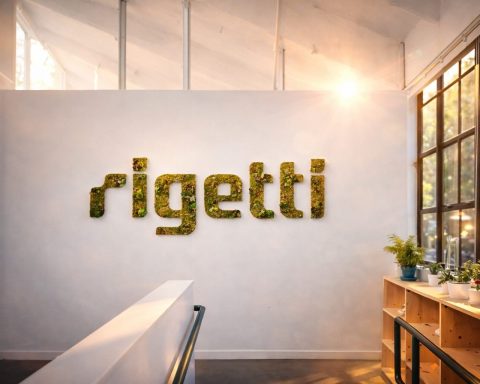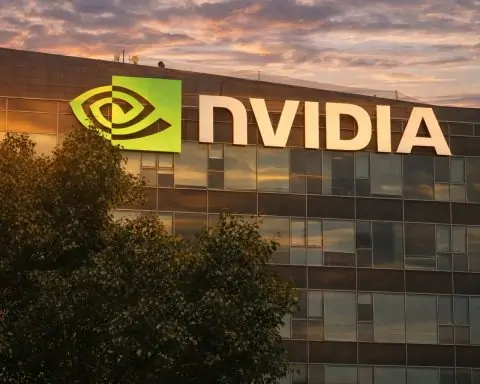- SoftBank announced a $2 billion equity investment in Intel at $23 per share for a stake just under 2%.
- Intel’s stock rose about 7% on the news, seen as a morale lifeline for its turnaround.
- Nvidia’s shares fell 3.5% on Tuesday, the biggest one-day drop in four months, ahead of its Aug. 27 quarterly results.
- Palantir plunged over 9% on Aug. 19, its fifth straight daily decline, with the weekly drop exceeding 15% after reporting first-half 2025 revenue above $2 billion and GAAP profitability.
- OpenAI private-market talks reportedly value the company at $500 billion, with employees potentially selling up to $6 billion of shares and SoftBank among buyers, versus a roughly $30 billion valuation in early 2023.
- U.S. Commerce Secretary Howard Lutnick said the government seeks an equity stake in Intel in exchange for CHIPS Act grants and suggested extending the approach to other chipmakers.
- Nvidia and AMD have agreed to a 15% revenue-sharing royalty on China sales to secure export approvals, with Nvidia’s China H20 chip currently affected by the regime.
- Arm Holdings, majority-owned by SoftBank, hired Amazon’s former senior AI chip director Rami Sinno to lead its AI chip efforts as CEO Rene Haas signals moving beyond designs.
- Baidu will report results on Aug. 20, 2025, after heavy AI investments in ERNIE and Apollo Go, with AI Cloud revenue up 42% year over year in Q1 and robotaxi rides up 75% to more than 11 million.
- Meta Platforms plans to price its Ray-Ban Stories smart glasses lower to drive adoption, sending the stock down about 2.3% on the news.
Market Mania Meets Reality in Tech Stocks
After months of euphoria, the once-unbridled enthusiasm for AI stocks is entering a “significant recalibration” as investors hit the brakes on some high-flying names [1]. Wall Street fell from recent records on Tuesday, with the Nasdaq Composite sinking about 1.5% as drops in Palantir and Nvidia – two stars of the AI boom – led the declines [2]. The S&P 500 shed 0.6% for its third straight loss, a notable pullback after the index set an all-time high just last week [3].
Investors appear to be taking profits and rethinking valuations in the AI space ahead of key events like Federal Reserve Chair Jerome Powell’s upcoming speech. “Stocks of artificial intelligence companies really seem to be growing on a trend that’s going to be very difficult to sustain,” warns Dean Smith, chief strategist at FolioBeyond [4]. The rapid run-up in AI shares has left them vulnerable to any hint of bad news or slowing growth. Nvidia – which had surged over 1,000% since late 2022 amid AI chip demand – tumbled 3.5% on Tuesday, its steepest one-day fall in four months [5]. The drop helped push the broader tech sector down nearly 2% and signaled a more cautious mood setting in before Nvidia’s eagerly awaited earnings next week. Meanwhile, smaller AI-centric players weren’t spared: voice recognition firm SoundHound AI saw its stock plunge roughly 7–8% intraday during Tuesday’s sell-off [6], exemplifying how jittery traders are pulling back even from lesser-known AI names. Overall, the mood has flipped from unbridled FOMO to a more sober assessment of fundamentals and price tags.
SoftBank Injects $2 Billion into Intel’s AI Ambitions
Amid the market cooldown, one bullish headline stood out: SoftBank is making a multi-billion-dollar bet on Intel. On Tuesday, the Japanese tech conglomerate announced it will invest $2 billion in Intel via a new equity stake of just under 2% [7]. SoftBank is paying $23 per share (a slight discount to Intel’s prior close) as part of this deal, which Intel’s new CEO Lip-Bu Tan welcomed as a much-needed lifeline for the chipmaker’s ambitious turnaround plans. Intel’s stock surged about 7% on the news [8], reflecting investor optimism that fresh capital and vote of confidence from SoftBank could bolster Intel’s bid to regain ground in semiconductor manufacturing and AI-oriented chips. “This strategic investment reflects our belief that advanced semiconductor manufacturing and supply will further expand in the United States, with Intel playing a critical role,” SoftBank CEO Masayoshi Son said in a statement [9], underscoring his conviction in Intel’s long-term importance in the AI hardware ecosystem. (SoftBank has been on an AI shopping spree this year – it recently committed a whopping $30 billion to OpenAI and led funding for other AI ventures [10].)
However, not everyone is convinced that SoftBank’s cash infusion will be a game-changer for Intel’s fortunes. “SoftBank’s investment helps, but it is not what is going to move the dial for Intel,” cautions Amir Anvarzadeh, a Japan equity strategist at Asymmetric Advisors [11]. The Silicon Valley icon is still grappling with heavy challenges – Intel lost nearly $19 billion in 2024 and has struggled to catch up to Asian rivals in chip manufacturing [12]. SoftBank’s funds provide a vote of confidence and extra runway, but Intel’s turnaround hinges on executing a very costly strategy to build out its contract foundry business and develop competitive AI chips. Tellingly, SoftBank’s own stock slipped 4% in Tokyo after unveiling the Intel deal [13], suggesting some investors worry Son may be stretching the conglomerate’s balance sheet or political goodwill.
The SoftBank-Intel tie-up also comes as Washington eyes a more direct hand in the semiconductor sector. In fact, U.S. Commerce Secretary Howard Lutnick said on Tuesday that the government wants an equity stake in Intel in exchange for federal grants under last year’s CHIPS Act [14]. That proposal – effectively turning some chip subsidies into an ownership interest – initially spooked Intel shareholders with dilution fears [15]. (Intel’s stock fell ~3–4% earlier in the week on reports the U.S. might convert $10+ billion of CHIPS Act aid into a ~10% government stake [16].) Now Lutnick is looking to extend that plan to other chipmakers, according to Reuters, as part of President Trump’s agenda to revive U.S. manufacturing [17]. The idea of Uncle Sam taking non-voting stakes in private companies is almost unprecedented, and it has raised eyebrows on Wall Street. “These developments signal that the U.S. government is heading in a concerning and more interventionist direction,” says IG market analyst Tony Sycamore, reacting to the Intel stake talk and other recent maneuvers [18]. Indeed, the Trump administration has been striking unusual bargains with tech firms: Nvidia and AMD have reportedly agreed to give the U.S. government a 15% cut of revenues from certain chip sales to China in order to receive export approvals [19]. Critics warn that such interventions create “new categories of corporate risk” and could put taxpayer funds on the line if these bets go bad [20]. For Intel, the stakes – both figurative and literal – have never been higher, as it now has to juggle private investors like SoftBank and potential public ownership stakes, all while executing a high-cost turnaround. In the near term, though, SoftBank’s cash injection has clearly given Intel a morale boost and a partner with deep pockets (and deep connections in AI) as it fights to reclaim its chip champion status.
Palantir’s Valuation Reckoning – Short Seller Sounds Alarm
No company embodies the 2023–2025 AI stock mania and its sudden reversal quite like Palantir Technologies. The data analytics and AI software firm saw its stock more than double earlier this year – at one point, Palantir even hit an all-time high after reporting its first-ever $1 billion revenue quarter [21]. The company became a poster child for AI-driven optimism, and its shares were up over 100% year-to-date through mid-August. But this week Palantir’s red-hot rally turned into a rout. The stock plunged over 9% on August 19 alone [22], its fifth consecutive daily decline, bringing the slide to more than 15% in just a week. That wipeout has erased a big chunk of Palantir’s summer gains and is forcing a hard look at whether the stock’s valuation got way ahead of its fundamentals.
What sparked Palantir’s abrupt fall from grace? In part, it was a scathing wake-up call from a famed short-seller. Andrew Left’s Citron Research – known for targeting overhyped stocks – revealed it has been shorting Palantir, and it published a new report arguing that Palantir is grossly overvalued [23] [24]. Citron’s analysis drew an eye-opening comparison: it held Palantir up against OpenAI (the maker of ChatGPT) as a benchmark. OpenAI is currently a private company reportedly raising funds at a $500 billion valuation (more on that later), and generates far less revenue than Palantir. Yet if you apply OpenAI’s generous price-to-sales multiple to Palantir, “the implied stock price would be about $40 per share,” Citron noted – roughly 77% below Palantir’s peak this week [25]. In Citron’s view, even a $40 price tag (Palantir was trading near $170 before the sell-off) would be “generous,” because that would still make Palantir one of the most expensive software companies ever [26]. In other words, Citron believes Palantir’s valuation had become completely “detached from fundamentals” – ironically so, given Palantir markets itself as a hyper-rational data analytics provider [27].
The short-seller broadside clearly rattled the market. Palantir’s stock, already fading from its highs, accelerated to the downside as the report circulated. It didn’t help that Palantir’s own CEO and co-founder, Alex Karp, has been a prolific seller of his stock during the run-up – unloading nearly $2 billion worth of shares over the past two years, according to Citron’s tally [28]. That kind of insider selling, Citron argues, signals that even Palantir’s top executive recognizes the stock may be overpriced. And it’s not just short-sellers raising caution flags: even Sam Altman – the CEO of OpenAI – commented recently that the AI sector is likely in a “bubble” [29]. When the man behind ChatGPT (and beneficiary of massive valuations himself) says AI stock prices may be unsustainable, it gives investors pause [30]. All these factors coalesced into a perfect storm of doubt around Palantir.
It’s worth noting that Palantir is growing and has finally achieved GAAP profitability this year, riding the wave of interest in artificial intelligence solutions for government and enterprise. The company’s revenues surpassed $2 billion in the first half of 2025, and it has touted new AI platform initiatives. However, the stock’s meteoric rise had stretched its valuation to extremes: even after the pullback, Palantir trades at a forward price-to-earnings ratio above 240 [31], orders of magnitude higher than more established software peers. Such a lofty multiple leaves zero margin for error. Any hint of growth deceleration or any credible critique (like Citron’s) that the “AI premium” has gone too far can send investors running – which is exactly what we saw. As one analyst quipped, the recent slump is “the air coming out of the AI balloon” for Palantir and its cohort of richly valued, story-driven stocks. The coming weeks will test whether Palantir can stabilize and prove the doubters wrong, or if further correction is in store as the market distinguishes genuine AI winners from those riding hype. For now, Palantir has become a cautionary tale that even in an AI-driven future, fundamentals and reasonable multiples still matter [32].
Nvidia’s Rally Faces a Reality Check (and China Tradeoffs)
Nvidia, the poster child of the AI hardware boom, also hit a road bump this week – though for somewhat different reasons. The Silicon Valley chip titan has been on an extraordinary tear, thanks to insatiable demand for its GPUs to power AI models in data centers. Nvidia’s stock has climbed roughly 35% in 2025 and had vaulted into the exclusive club of trillion-dollar market cap companies. At one point, Nvidia’s valuation even eclipsed that of Microsoft, making it the world’s most valuable company for a brief spell [33]. But such sky-high expectations mean the bar is extremely high, and investors are getting skittish about anything that could derail Nvidia’s narrative. On Tuesday, Nvidia shares slid 3.5% – their biggest one-day drop since the spring [34] – as part of the broader tech sell-off. That dip contributed to Nvidia logging its first weekly loss in over two months, signaling that “AI fever” around this stock has cooled, at least for now [35]. Analysts pinned the decline on a mix of profit-taking and pre-earnings jitters. Nvidia is set to report quarterly results on Aug. 27, and after its stock’s stratospheric run, some traders are reluctant to press bets further without seeing confirmation that its growth can justify a valuation of over 40 times projected 2026 earnings (and more than 20 times sales) [36]. “The AI outlook did not show the sort of upside some investors were looking for,” Jefferies analysts said of Nvidia’s recent trends [37], noting that any slight disappointment in its upcoming earnings or guidance could spur a rush to the exits. In short, Nvidia’s stock is priced for perfection – and in a choppier market environment, even the slightest whiff of imperfection can prompt a pullback.
Beyond general market nerves, Nvidia is navigating complex geopolitical currents that could shape its growth trajectory. A huge portion of Nvidia’s revenue growth has come from selling advanced AI chips to cloud providers and enterprises in China – a market now threatened by U.S. export restrictions. Last year, the U.S. government barred Nvidia from selling its top-tier A100 and H100 AI chips to Chinese customers without a license, citing national security concerns over Chinese AI advancements. Nvidia responded by creating a slightly pared-down chip for China called the H20, designed to meet U.S. rules. Now, in a fascinating development, Reuters reports that Nvidia is secretly developing a new AI chip for China – code-named the B30A – that will be even more powerful than the H20 yet (hopefully) still export-compliant [38] [39]. The B30A is based on Nvidia’s latest “Blackwell” chip architecture and will use a single-chip design (as opposed to the dual-die configuration in its flagship top-end GPUs) to reduce performance to a level U.S. regulators might tolerate [40] [41]. Nvidia is reportedly aiming to deliver sample units of this B30A chip to Chinese tech companies as early as next month [42] – an aggressive timeline reflecting how crucial the China market is, even as Washington’s rules evolve.
Interestingly, President Donald Trump signaled just last week that he may be open to letting Nvidia sell more advanced chips in China if certain conditions are met [43]. But such approvals are far from guaranteed given the “deep-seated fears in Washington” about China gaining access to cutting-edge AI technology [44]. Commerce Secretary Howard Lutnick – who has a say in export licenses – acknowledged Nvidia CEO Jensen Huang’s relentless lobbying on this front. “Of course Jensen would like to sell a new chip to China,” Lutnick told CNBC, adding that Huang has been “pitching the president all the time” on the idea [45]. “The president listens to our great technology companies, and he’ll decide how he wants to play it,” Lutnick said, praising Huang’s efforts while stopping short of indicating which way the decision will go [46]. In the meantime, Nvidia (and its peers like AMD) have had to strike creative compromises. As mentioned, Nvidia’s current H20 sales to China are being allowed only under an unusual arrangement where the U.S. government takes a 15% royalty cut of those China revenues [47]. Reuters revealed this week that AMD – which also makes AI-capable chips – has agreed to a similar 15% revenue-share with the U.S. for certain chip shipments to China [48]. These deals effectively tax the chipmakers’ China business in exchange for keeping some access to that market. They also underscore how Trump’s administration is willing to micromanage AI supply chains, blurring the lines between public policy and private enterprise.
For Nvidia, the near-term impact of such measures is likely manageable – China comprised about 13% of Nvidia’s revenue last year [49], and demand elsewhere (U.S. cloud giants, etc.) has been more than enough to fuel record sales. But longer term, the company must perform a delicate balancing act: maintaining its dominance in AI computing while appeasing U.S. regulators and navigating geopolitical fractures. Nvidia’s stock, still up over 180% in the past 12 months, remains a favorite on Wall Street, but it’s no longer the one-way moonshot it appeared to be earlier in the AI frenzy. Investors are now discerning between hype and reality, and Nvidia will have to deliver nearly flawless execution – and perhaps a diplomatic coup in Washington – to keep its momentum going at the same blistering pace [50].
Global Ripple Effects and Regulatory Crosswinds
The tumult in U.S. AI stocks is reverberating worldwide, reminding everyone that the AI boom (and any potential bust) is a global story. By Wednesday morning in Asia, shares across the region slipped in sympathy with Wall Street’s tech-led sell-off [51]. Japan’s Nikkei index fell about 1.2%, and China’s blue-chip CSI 300 index dropped 0.5% [52], as investors from Tokyo to Shenzhen digested the implications of an American tech correction. European markets initially showed some resilience – the STOXX Europe 50 had notched gains the day before even as U.S. markets slid [53] – but European futures turned down about 0.5% by early Wednesday, also catching the downdraft [54]. “Investors ditched high-flying tech stocks with their lofty valuations,” one analyst in Singapore noted, adding that the frenzy around AI stocks was facing its first real test of confidence globally [55].
Regulatory developments are also playing a growing role in shaping the AI investment landscape. The U.S. government’s increasingly hands-on approach – from seeking ownership stakes in chip companies to extracting revenue-sharing from Nvidia/AMD’s China sales – has introduced new uncertainty. While aimed at securing America’s technological edge and supply chain, these moves could pinch profits or complicate corporate strategies for AI companies operating internationally. The Biden administration had already imposed strict export controls on AI chips in 2022; now the Trump administration (back in office after 2024) is doubling down with novel interventionist tactics [56] [57]. This has not gone unnoticed by investors and executives abroad. “These developments signal that U.S. government involvement is heading into uncharted territory,” says IG’s Tony Sycamore, warning that such policies “create new categories of risk” for companies and could even spur retaliation or competitive moves by other countries [58] [59]. For example, China has already started restricting exports of certain critical minerals used in chipmaking, a tit-for-tat response that could raise costs for U.S. chip firms. In Europe, regulators are taking a different tack – focusing more on AI governance and antitrust than direct investment – but the effect could still be significant on companies like Google, Meta and others deeply invested in AI. (Just this week, Google agreed to tweak its app store rules under EU pressure, a reminder that Big Tech’s AI-fueled market power faces pushback in the EU [60] [61].)
One striking example of the global AI race’s intensity is the private market frenzy surrounding OpenAI. Despite not being publicly traded, OpenAI’s fortunes influence the entire sector’s sentiment. This week, news leaked that OpenAI is in talks for a possible share sale that would value the ChatGPT creator at a jaw-dropping $500 billion – which would make it the world’s most valuable private company, surpassing even Elon Musk’s SpaceX [62] [63]. The potential deal involves OpenAI employees selling up to $6 billion worth of their shares to investors, with heavyweights like SoftBank reportedly among the interested buyers [64] [65]. To put that in context, OpenAI was valued around $30 billion in early 2023; achieving a half-trillion valuation now, roughly a 17x increase in two years, underscores how frothy expectations around AI have become. Investors from Silicon Valley to Abu Dhabi are clamoring for a piece of the next potential AI goldmine, even as public markets are flashing caution signals. The fact that serious money is considering OpenAI at $500B – more than legacy giants like VISA or ExxonMobil are worth – shows that hype in the AI arena is still alive and well in certain corners [66]. Of course, such a valuation would rest on OpenAI’s growth prospects in selling AI models and services, which remain to be proven over the long term. The dichotomy is fascinating: on public exchanges, AI stocks are pulling back from nosebleed levels, but behind closed doors, private valuations are pushing ever higher.
Industry Updates: Partnerships, Products, and Earnings to Watch
Amid the market volatility, AI companies large and small continue to forge partnerships and launch products, knowing that long-term value will come from real technological and commercial progress. In the semiconductor industry, we’re seeing intriguing cross-pollination: U.K.-based chip designer Arm Holdings – fresh off its late-2023 IPO – is now hiring top talent from Amazon to bolster its AI chip efforts. This week Arm poached Rami Sinno, Amazon’s former senior AI chip director (who helped create Amazon’s Trainium and Inferentia AI chips), to lead Arm’s push into designing its own high-performance semiconductors [67]. Historically, Arm has focused on licensing its chip architecture to others rather than making its own chips, but as AI workloads grow, Arm’s CEO Rene Haas has hinted at moving “beyond designs” into producing more complete chip solutions [68]. The Sinno hire confirms Arm’s seriousness about that shift. It’s a strategic gamble aimed at ensuring Arm’s technology remains central to the AI revolution – especially as rivals like Nvidia encroach on Arm’s territory by developing CPU cores, and as customers demand tightly integrated AI system-on-chips. Arm’s stock (which trades in New York) has been relatively steady, but analysts say breakthroughs in proprietary AI chips or “chiplets” could unlock new revenue streams for the company in data centers and edge AI devices. This is definitely an AI hardware story to watch, given SoftBank’s majority ownership of Arm and the broader context of competition between chip ecosystems.
In the consumer and software arena, Big Tech firms are racing to infuse AI into their products, sometimes at the expense of short-term margins. Case in point: Meta Platforms (Facebook’s parent) revealed plans to price its upcoming smart glasses lower than expected in order to drive adoption [69]. These next-gen Ray-Ban Stories glasses will integrate Meta’s AI and augmented reality features, and the aggressive pricing is meant to undercut rivals and put AI-enhanced wearables into more hands (or on more faces). Investors, however, fretted that this strategy could squeeze Meta’s hardware profit margins – Meta’s stock dipped about 2.3% on the announcement [70]. Still, the move highlights how determined Meta is to be a leader in consumer AI gadgets (part of CEO Mark Zuckerberg’s push into the metaverse and AR). Similarly, Microsoft and Google continue to invest billions in cloud AI services and copilot tools for businesses, even if those investments weigh on near-term earnings. In enterprise software, we’ve seen a flurry of partnerships where incumbents tie up with AI startups to enhance offerings – for example, cloud HR provider Workday just announced an expanded alliance with IBM’s Watson AI to build new AI features into HR workflows (a logical pairing of software and AI expertise). Such developments may not move stock prices immediately, but they demonstrate that the competitive moat in many industries will hinge on AI capabilities, keeping the sector’s long-term growth story intact.
On the earnings front, the next few days will be pivotal for several AI-exposed companies outside the U.S. In China, search giant Baidu is set to report results on Aug. 20, and investors are keen to see how its heavy pivot to AI is paying off. Baidu has poured resources into generative AI models (its ERNIE chatbot aims to rival ChatGPT) and into autonomous driving, where its Apollo Go robotaxi service just crossed 11 million ride trips. Those new AI-centric units saw explosive growth last quarter – Baidu’s AI Cloud revenue jumped 42% year-over-year in Q1, and robotaxi rides surged 75% [71] [72]. The stock trades at a relatively modest valuation (about 9 times earnings, a fraction of U.S. AI peers) [73], partly due to China’s slower economy and geopolitical overhangs. If Baidu’s Q2 numbers show that AI services can offset weakness in its older search advertising business, it could bolster the bull case that Baidu is undervalued as a “Chinese AI champion.” Conversely, any hiccup could reinforce the skepticism that China’s macro issues are holding back even its tech leaders. Either way, Baidu’s report will offer another data point on global AI adoption. Also in focus will be chip equipment makers like ASML and smaller AI chip startups, which thus far have been riding Nvidia’s coattails – a sustained Nvidia correction could trickle down to sentiment on those names as well.
Finally, it’s important to note that despite the recent turbulence, the long-term transformative potential of AI remains undiminished. Many analysts stress that we are in the early innings of a multi-year (perhaps multi-decade) revolution that will reshape industries – from healthcare to finance to transportation – and create enormous value for the companies that emerge as leaders. “While the long-term transformative potential of AI remains undisputed, the current environment highlights the inherent volatility and risks associated with high-growth, richly valued sectors,” one market commentary noted [74]. In other words, a dose of market discipline may actually be healthy, separating the truly innovative, revenue-generating AI businesses from those mostly riding on hype. For investors, the past two days have been a whipsaw reminder that AI stocks won’t go up in a straight line. But with major players continuing to invest heavily (the Big Tech giants have spent a combined $155 billion on AI development just in 2025 [75]) and with groundbreaking AI applications rolling out seemingly every week, the sector’s news flow – and yes, its stock volatility – is sure to remain intense. In the end, this week’s global AI stock roundup shows a market searching for equilibrium: exuberance tempered by reality checks, big bets balanced by bouts of risk-off caution. The result is a sharper, more analytical outlook – fitting, perhaps, for a field built on intelligence, both artificial and human.
Sources: Reuters, Associated Press, Nasdaq/Zacks, Business Insider, Investing.com, The Guardian [76] [77] [78] [79] [80] [81] [82] [83] [84] [85] [86] [87]
References
1. markets.financialcontent.com, 2. apnews.com, 3. apnews.com, 4. www.reuters.com, 5. www.reuters.com, 6. stockstotrade.com, 7. www.reuters.com, 8. www.reuters.com, 9. www.reuters.com, 10. www.reuters.com, 11. www.reuters.com, 12. www.reuters.com, 13. www.reuters.com, 14. www.reuters.com, 15. www.nasdaq.com, 16. www.nasdaq.com, 17. www.reuters.com, 18. www.reuters.com, 19. www.reuters.com, 20. www.reuters.com, 21. markets.financialcontent.com, 22. markets.financialcontent.com, 23. www.businessinsider.com, 24. www.businessinsider.com, 25. www.businessinsider.com, 26. www.businessinsider.com, 27. www.businessinsider.com, 28. www.investing.com, 29. www.investing.com, 30. www.investing.com, 31. markets.financialcontent.com, 32. markets.financialcontent.com, 33. markets.financialcontent.com, 34. www.reuters.com, 35. markets.financialcontent.com, 36. markets.financialcontent.com, 37. www.reuters.com, 38. www.reuters.com, 39. www.reuters.com, 40. www.reuters.com, 41. www.reuters.com, 42. www.reuters.com, 43. www.reuters.com, 44. www.reuters.com, 45. www.reuters.com, 46. www.reuters.com, 47. www.reuters.com, 48. www.reuters.com, 49. www.reuters.com, 50. markets.financialcontent.com, 51. www.reuters.com, 52. www.reuters.com, 53. www.reuters.com, 54. www.reuters.com, 55. www.reuters.com, 56. www.reuters.com, 57. www.reuters.com, 58. www.reuters.com, 59. www.reuters.com, 60. www.reuters.com, 61. www.reuters.com, 62. www.theguardian.com, 63. www.theguardian.com, 64. www.theguardian.com, 65. www.theguardian.com, 66. www.theguardian.com, 67. www.reuters.com, 68. www.reuters.com, 69. www.nasdaq.com, 70. www.nasdaq.com, 71. www.tastylive.com, 72. www.tastylive.com, 73. www.tastylive.com, 74. markets.financialcontent.com, 75. www.theguardian.com, 76. apnews.com, 77. www.reuters.com, 78. www.reuters.com, 79. www.reuters.com, 80. www.reuters.com, 81. www.businessinsider.com, 82. www.investing.com, 83. markets.financialcontent.com, 84. www.reuters.com, 85. www.reuters.com, 86. www.reuters.com, 87. markets.financialcontent.com










